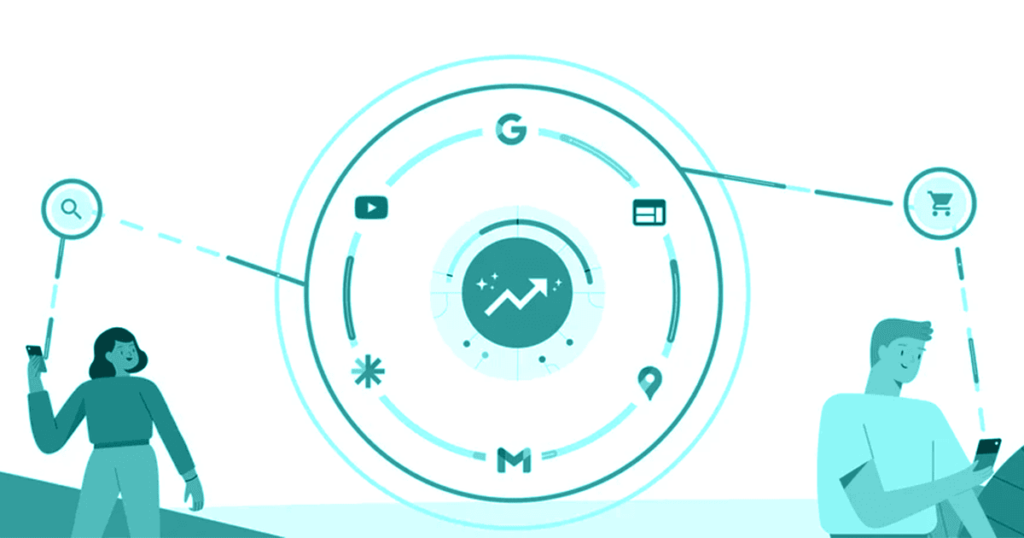Why Proper Attribution In Search Is More Complex Than Your Reports Tell You.
In our interactions, we find that upwards of 80% of clients and prospects that come to us are reporting on paid search and organic search as two separate channels with siloed analysts or agency teams. To a certain degree, this makes sense — I spend X on PPC, I want to see 3X back on PPC. Same scenario for SEO — I want to understand my return for the channel and what my growth metrics are for a given time period. Google Shopping campaigns (PLAs), add another isolated layer to the mix.
The problem is the Google search-engine results page (SERP) is a closed ecosystem with three main parts that play off each other. Still, it’s so common to think about them in isolation in strategy meetings.

“Upwards of 80% of businesses are reporting on paid and organic search separately but not holistically.”
So, let’s dig into the relationship between these three channels a bit. In Q4, 2020, Merkle reports that there were 12% more clicks to paid search listings the prior year while organic search was up 31%. Note that overall search queries are up 28% for this time period — they’re just going to organic more than in the previous year. This is the first positive growth change for organic search (as a percent of total) in many years.
So, SEO starts off 2021 with ~31% growth booster vs. 2020. Is paid search taking a hit in your campaigns? It would be hard to think so when SEM clicks are also up 12% YoY. Again, Google has one results page with three (main) parts. All three pieces invariably play off one another with regard to search behavior. We’ll get into dissecting the strengths and weaknesses of each for different goals in upcoming articles.
For now, it’s important to understand that cannibalism is likely obfuscating true growth at the total-SERP level, and this will impede good business decisions when it comes to investing in search marketing.
You’ve probably run into a few of these common scenarios:
Paid search is going well. Maybe you allocate a 10% budget lift for the month, and you stay within Return on Advertising Spend (ROAS) targets. Fantastic! Except that this month, you notice SEO is off.
Shopping ads are becoming more and more popular, and as much as 80% of ad budgets are now going to this channel. You have a fantastic quarter (YoY), but SEO product-page sessions/sales are now lackluster.
Your organic traffic to a popular category page drops off — you have the top rankings in a niche vertical where there’s little competition. You Google several terms you know to be driving traffic, and you see your text ad directly above your organic listings.
In these three scenarios, when you have your reporting and your management siloed by channel, it would be easy to miss the signals that cannibalization is happening. The problem is, now you want to go to your teams to say, “why is performance down?” These folks have key performance metrics that are often at odds with one another when you consider that search is a zero-sum game. If SEO is off due to a big push in Search Engine Marketing (SEM), putting that pressure onto SEO to make up ground irrespective of the paid initiatives won’t necessarily make it rain.
Tell the SEM analyst that sales are down, and they’ll recommend increasing bids as long as we stay within ROAS targets. Tell the SEO analyst the same thing, and he may tell you that rankings are up and struggle to point to where the deficit is coming from. They’re both doing their jobs correctly, but what’s missing is a unifying conversation about a holistic approach to reporting on the entire SERP.
So, how do we bring these three channels together in a way that’s better for the business as a whole? First, let’s understand the advantages of a holistic approach to search marketing. Here are some ways our three channels impact each other.
The Growth Of Paid Real Estate
First, understand that Google will, in all likelihood, continue its march forward with paid listings dominating the SERP. Each year, SEO will see new handicaps with regard to the size of the pie to be divided up among your competitors in organic. SEO is still a very (I repeat, a VERY) productive channel, and unless you own the top listings across the board, there is revenue to be mined here. Still, it’s important to keep the awareness that flat numbers in SEO represent growth when balanced with our 11% handicap. Therefore, if you’re not seeing growth in text ads and shopping, there may be missed opportunities here.
Shopping Ads Eat Into Product SEO With Incremental Value
As we look at the rise of Google Shopping traffic in the SERP over the past several years, there is a clear correlation to a decline in SEO traffic to product-detail pages (PDPs). But the sum of Google Shopping Ads+SEO is considerably greater than SEO on its own. Businesses should not abandon ongoing SEO efforts to rank for product pages. SEO traffic to PDPs is among the most productive, often resulting from highly relevant, long-tail search queries.
Brand Traffic Flows Through All Channels — Segment And Analyze
We talk frequently about the importance of understanding the difference between brand- and non-brand-keyword traffic in both paid and organic search. In short, brand queries like Acme or Acme Widget often yield highly qualified shoppers who are using Google navigationally to come and buy something. This is very different search intent than someone Googling Widget, and the conversion rates between the two classifications (brand versus non-brand) will be night and day.
It’s easy to segment brand and non-brand sessions in text ads and shopping, but it’s also important to understand that the vast majority of brand traffic to SEO will go through the home page. While there are several ways to approach understanding non-brand SEO sessions and sales, a quick, directional analog is to look at all SEO traffic where you filter out the home page.
For our purposes here, we want to look for trends. Do we have any special pushes or promotions happening in text ads that are drawing the eye in the SERP? If you find SEO home-page sessions took a hit this week, look first to see what changes are happening with regard to spend in brand text and shopping-ad campaigns.
Text Ads And Shopping Ads Bump SEO
As stated earlier, shopping and text ads obviously push organic listings further down the page — very often “below the fold.” While we know there to be incremental value in having all three listing types, it is possible to shoot oneself in the foot. In a scenario where you dominate both shopping and text ads, and you have the top organic listing, it’s important to run some analysis — review Auction Insights reports and consider bidding down on low-competition terms that could be easily retained organic listings. See example here:

Keyword Value Is Not Significantly Different B/W Paid And Organic Search
If you know that “Blue Lightweight Widgets” is a keyword that delivers a steady 4:1 return all day, every day in text ads, it will do well for organic SEO, too. Do you have a list of high-value terms like this where you throw as much ad spend as you can at it? Your SEO team wants to know.
Because Google hides most keyword data as it relates to sales, that door doesn’t swing both ways for SEO to share back, but your SEO team should know which products and categories do very well in terms of organic conversion rates. Sharing this intel with the SEM team (along with data about the keywords that are ranking for those pages) could yield productive insights.
Next Steps: Unify Your Teams For A Holistic Approach
So! How do we make use of this information? If you have fragmented teams or reports or if you’re not currently fostering a unified-SERP agenda, here are seven steps you can take toward a more productive, cross-channel dialogue and strategy.
First, think about the motivation of the folks on your various teams. Do they have conflicting KPMs? Do you have one agency managing SEM and another on SEO? It would be easy for them to point fingers at one another rather than work together as a group — especially if each team is not seeing the reports of the other on a regular basis.
Create and broadcast a central, unified SERP report to the group and to the business. Making the combined, overall performance of search part of the regular marketing dialogue is critical when you’re trying to change perceptions about responsibilities.
Share keyword targets from text ads AND mine your shopping KWs as an additional research tool. SEO moves much more slowly than SEM. If we have a clear understanding of high-value targets from the paid side, we can feel more confident that we’re investing time and resources into ranking for the right keywords organically.
There is some reciprocity here as well. SEO can report back to SEM on which landing pages offer the highest conversion rates, and pair those pages with the target organic keywords we believe to be driving traffic.
Create an understanding of which keywords may be struggling in each channel. If cost is prohibitively expensive for a keyword in text ads, task the organic team with finding a path to organic ranking. If impression share is low in SEM, it may be possible to offset this with organic. When the SEO competition is high for business-driving terms, ensure the paid team is aware of the potential opportunity so they can test more aggressive bid strategies.
Create awareness that product SEO is a benefit to shopping campaigns. When products are optimized for search keywords, the benefit can carry over to help products show up with better relevance in shopping campaigns. For example, a product named “Summerweight Cords” will get increased visibility and more qualified traffic when optimized for the key phrase, “Lightweight Corduroy Pants.” Encourage a dialogue between teams to talk about what’s working and what would be helpful for product pages from both perspectives.
Both teams are considering landing-page experience and conversion. Bring strong minds together on this to focus on pages both teams deem to be high value. Compile a list of landing pages that receive high traffic and reasonable conversion, and determine what opportunities might exist to split test changes for improved conversion rates. In many cases, it’s not difficult to put a potential value on the initiative to get the test approved.
Unify the search-marketing voice to make things happen (I’m looking at you, IT). Marketing always has to jockey for position on the IT project list with half a dozen other departments. When SEO and SEM work together, there is increased value for projects that overlap. For example, both channels are always looking at site speed as a factor in conversion rates and organic rankings. When SEO has a value of X for site-speed improvements, and SEM has a value of Y, chances are good the combined value is more likely to impress to where the project makes the cut. Think about the possibilities of a unified voice to represent search in conversations with User Experience (UX), merchandising, acquisition, etc.…
In an omni-channel environment, marketers are thinking about how to piece together the customer journey across all efforts including retail, catalog, advertising, digital, etc.… As we consider these big-picture attribution models, we have an immediate opportunity to consolidate three channels within digital to operate both individually and as one whole. A holistic approach to search marketing will lead to better intelligence, smarter investing, and tighter teamwork.





